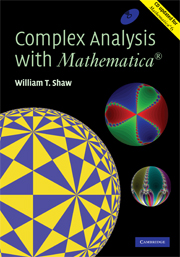Book contents
- Frontmatter
- Contents
- Preface
- 1 Why you need complex numbers
- 2 Complex algebra and geometry
- 3 Cubics, quartics and visualization of complex roots
- 4 Newton—Raphson iteration and complex fractals
- 5 A complex view of the real logistic map
- 6 The Mandelbrot set
- 7 Symmetric chaos in the complex plane
- 8 Complex functions
- 9 Sequences, series and power series
- 10 Complex differentiation
- 11 Paths and complex integration
- 12 Cauchy's theorem
- 13 Cauchy's integral formula and its remarkable consequences
- 14 Laurent series, zeroes, singularities and residues
- 15 Residue calculus: integration, summation and the argument principle
- 16 Conformal mapping I: simple mappings and Möbius transforms
- 17 Fourier transforms
- 18 Laplace transforms
- 19 Elementary applications to two-dimensional physics
- 20 Numerical transform techniques
- 21 Conformal mapping II: the Schwarz—Christoffel mapping
- 22 Tiling the Euclidean and hyperbolic planes
- 23 Physics in three and four dimensions I
- 24 Physics in three and four dimensions II
- Bibliograpy
- Index
2 - Complex algebra and geometry
Published online by Cambridge University Press: 05 August 2014
- Frontmatter
- Contents
- Preface
- 1 Why you need complex numbers
- 2 Complex algebra and geometry
- 3 Cubics, quartics and visualization of complex roots
- 4 Newton—Raphson iteration and complex fractals
- 5 A complex view of the real logistic map
- 6 The Mandelbrot set
- 7 Symmetric chaos in the complex plane
- 8 Complex functions
- 9 Sequences, series and power series
- 10 Complex differentiation
- 11 Paths and complex integration
- 12 Cauchy's theorem
- 13 Cauchy's integral formula and its remarkable consequences
- 14 Laurent series, zeroes, singularities and residues
- 15 Residue calculus: integration, summation and the argument principle
- 16 Conformal mapping I: simple mappings and Möbius transforms
- 17 Fourier transforms
- 18 Laplace transforms
- 19 Elementary applications to two-dimensional physics
- 20 Numerical transform techniques
- 21 Conformal mapping II: the Schwarz—Christoffel mapping
- 22 Tiling the Euclidean and hyperbolic planes
- 23 Physics in three and four dimensions I
- 24 Physics in three and four dimensions II
- Bibliograpy
- Index
Summary
Introduction
In the first chapter you saw why you need imaginary and complex numbers, by considering the solution of simple quadratic equations. In this chapter you will see how we set up complex numbers in general, and establish their basic algebraic and geometrical properties.
We shall assume that you have some understanding of what is meant by a real number. The exact nature and depth of this understanding will not materially affect the discussion thoughout most of this book, and this is not a book about the fundamentals of real analysis. We should, however, take a moment to remind ourselves what a ‘real’ number is, before we start defining ‘imaginary’ and ‘complex’ numbers. Students of pure mathematics should remind themselves of the details of these matters — there is really nothing for it but to go for a proper mathematical definition, and experience has shown that one needs to be slightly abstract in order to get it right, in the sense that the resulting definition contains all the numbers ‘we need’. For a full exposition, complete with proofs, you should consult a text on real analysis, such as that by Rudin (1976). For our purposes it will mostly be sufficient to regard real numbers as being all the points on a line (which we call the real axis) extending to infinity in both directions.
- Type
- Chapter
- Information
- Complex Analysis with MATHEMATICA® , pp. 10 - 40Publisher: Cambridge University PressPrint publication year: 2006



